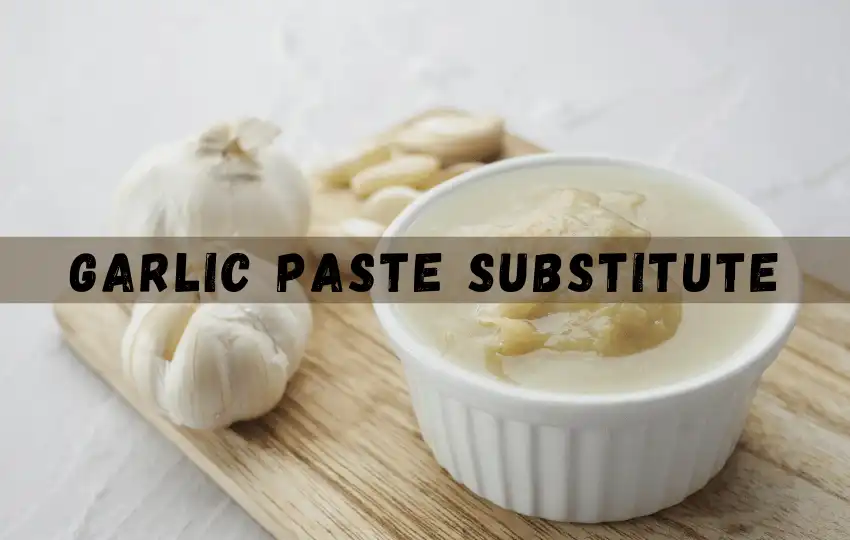Garlic has been a main ingredient in many households across the globe. It adds flavor to your dishes and enhances the overall taste.
However, making garlic paste from scratch can take up too much time, and some people find it too overpowering.
Hence, it’s important to know some ideal garlic paste substitutes you can use in your cooking.
As an experienced home cook and chef, I’m happy to share with you 9 of the best garlic paste substitutes that you can add to your dishes, along with their ideal ratio.
In short, " What can I use instead of garlic paste?" Garlic Powder, Minced Garlic, Garlic Salt, Roasted Garlic, Garlic Puree, Shallots, Ginger, Garlic Oil, Garlic Flakes.
What is garlic paste, and what does garlic paste taste like?
Garlic paste is a culinary preparation made by crushing or blending fresh garlic cloves into a smooth, thick consistency.
It is normally used as a flavoring agent in various cuisines around the world.
Garlic paste retains the pungent and distinct flavor of fresh garlic, but its intensity can vary depending on the amount of garlic used and individual preferences.
The taste of garlic paste is characterized by its strong, aromatic, and slightly spicy flavor. It has a sharp and pungent bite with a hint of sweetness.
The taste of garlic paste can be described as bold, savory, and robust. When raw, garlic paste can have a potent and assertive flavor that mellows when cooked, becoming milder and sweeter.
The flavor profile of garlic paste enhances the taste of dishes, adding depth and complexity. It is widely used in sauces, marinades, dressings, stir-fries, soups, and other savory recipes.
The intensity of the garlic flavor can be adjusted by using more or less paste in a dish, allowing for customization based on personal preference.
Overall, garlic paste is a versatile ingredient that adds a distinctive and flavorful element to a wide range of dishes, and its taste can greatly enhance the overall culinary experience.
Uses of garlic paste
Garlic paste is a versatile ingredient used in various dishes to enhance their flavor and aroma. Here are some common uses of garlic paste in cooking:
1. Sauces and Marinades: Garlic paste is commonly used as a main ingredient in sauces and marinades. It adds a rich and robust flavor to dishes like pasta sauces, stir-fry sauces, barbecue marinades, and salad dressings.
2. Soups and Stews: Adding garlic paste to soups and stews provides a depth of flavor and enhances the overall taste. This can be used in many types of soups, such as tomato soup, lentil soup, chicken noodle soup, and vegetable soup.
3. Stir-fries and Sautéed Dishes: Garlic paste is a staple in stir-fries and sautéed dishes. This is often combined with other ingredients like vegetables, meats, or seafood to create aromatic and flavorful dishes.
4. Roasted and Grilled Meats: Garlic paste can be used as a seasoning for roasted or grilled meats. It adds a delicious flavor when rubbed onto chicken, beef, lamb, or pork before cooking.
5. Dips and Spreads: Garlic paste is an excellent addition to dips and spreads. It can be mixed with ingredients like yogurt, mayonnaise, or cream cheese to create flavorful spreads for bread, crackers, or vegetables.
6. Bread and Pizzas: Garlic paste can be brushed onto bread or pizza crusts to add a delicious garlic flavor. It is often combined with butter or olive oil to create a garlic butter spread.
7. Pasta and Risotto: Garlic paste can be added to pasta sauces and risotto to infuse them with a distinct garlic taste. It works well in both creamy and tomato-based sauces.
8. Seasoning and Seasoning Blends: Garlic paste can use as a seasoning for various dishes. It is often combined with herbs, spices, and other seasonings to create flavorful blends for rubs, dressings, and marinades.
These are rare examples of the many uses of garlic paste in cooking. Its versatility makes it a valuable ingredient in the kitchen, allowing you to add depth and flavor to a wide range of dishes.
Where to buy garlic paste?
If you are looking for where to buygarlic paste, there are a few different places you can go. Many specialty food stores carry it, as do some international grocery stores.
You can also order online from many retailers that provide a variety of diverse flavors and types of garlic paste.
Best garlic paste substitutes & their measurement
1. Garlic Powder
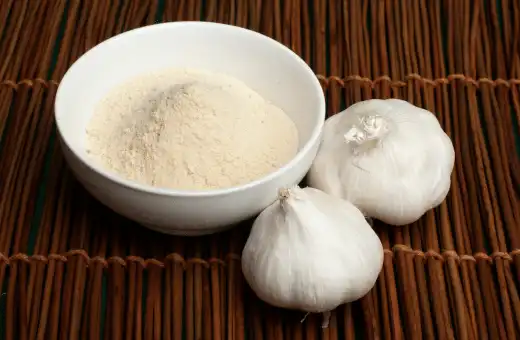
Garlic powder is one of the common substitutes for garlic paste.
Ratio or measurement: The ideal ratio for garlic powder is one teaspoon of powder for every two cloves of garlic.
It is easy to find in all grocery stores and has a long shelf life than fresh garlic.
2. Minced Garlic
If you don’t like the hassle of making garlic paste, minced garlic is an excellent substitute.
Ratio or measurement: The ideal ratio for minced garlic is one and a half teaspoons of minced garlic for every two cloves of garlic.
It’s readily available in stores and has a long shelf life.
3. Garlic Salt
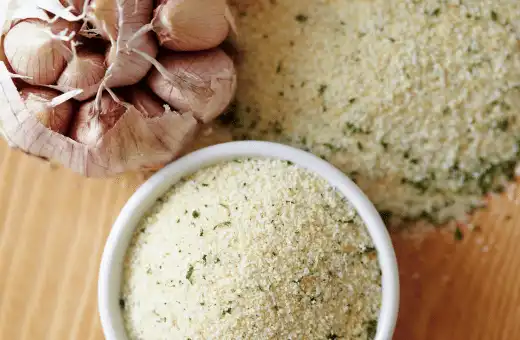
Garlic salt is a mix of garlic powder and salt you can use as a seasoning or a substitute for garlic paste.
Ratio or measurement: The ideal ratio for garlic salt is one teaspoon of garlic salt for every two cloves of garlic.
However, you have to reduce the amount of salt in the recipe since garlic salt already contains salt.
4. Roasted Garlic
Roasted garlic has a sweet and earthy flavor that’s perfect for a wide range of dishes. You can mash it or chop it into small pieces depending on your preference.
Ratio or measurement: The ideal ratio for roasted garlic is four to five cloves of roasted garlic for every two cloves of garlic.
5. Garlic Puree
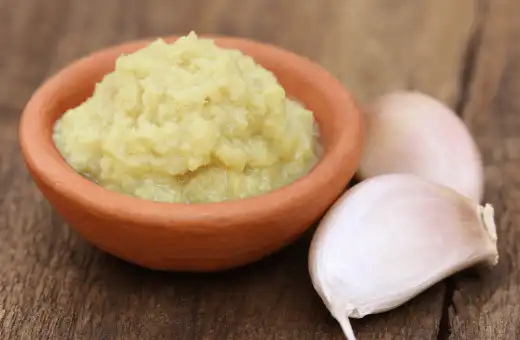
Garlic puree is a great substitute for garlic paste since it has a similar texture and consistency. Can use a blender or food processor also to make garlic puree.
Ratio or measurement: The ideal ratio for garlic puree is two tablespoons of puree for every three cloves of garlic.
6. Shallots
Although shallots don’t taste exactly like garlic, they have a mild onion flavor that can add depth to your dishes. You can use shallots as a substitute for garlic paste if you can’t tolerate the strong garlic flavor.
Ratio or measurement: The ideal ratio for shallots is two tablespoons of minced shallots for every three cloves of garlic.
7. Ginger
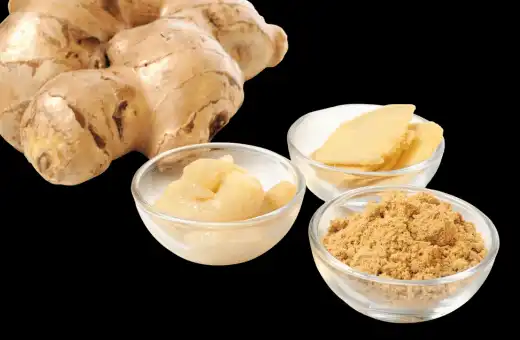
If you’re looking for a substitute that adds a refreshing and spicy kick to your dishes, ginger is an excellent option.
It is the exact texture and consistency of garlic paste, making it a perfect substitute.
Ratio or measurement: The ideal ratio for ginger is two teaspoons of minced ginger for every two cloves of garlic.
8. Garlic Oil
Garlic oil is a flavorful substitute for garlic paste, and it is used in recipes that require oil or frying.
Ratio or measurement: One tablespoon of garlic oil equals one clove of fresh garlic. Use two tablespoons of garlic oil instead of one tablespoon of garlic paste in your recipe.
9. Garlic Flakes

Garlic flakes are dehydrated garlic, and they are a great substitute for garlic paste in recipes that require a strong garlic flavor.
Ratio or measurement: One-half teaspoon of garlic flakes is equivalent to one fresh garlic clove. Use two teaspoons of garlic flakes in place of one tablespoon of garlic paste in your recipe.
Non-garlic paste options for recipes
If you’re looking for non-garlic paste options to substitute in recipes, there are several alternatives that can provide similar flavors or different taste profiles. Here are a few options:
1. Ginger Paste
Ginger paste is a popular ingredient in many cuisines. It adds a zesty, slightly spicy, and aromatic flavor to dishes.
Use it in stir-fries, marinades, soups, and sauces for a vibrant and refreshing taste.
2. Onion Paste
Onion paste can be used as a flavor base in various recipes. It offers a sweet and savory taste that complements meats, vegetables, and sauces. It works well in curries, stews, and sautéed dishes.
3. Tomato Paste
Tomato paste is a thick form of tomatoes with a rich, tangy, and slightly sweet savor. This is often used as a thickener and flavor enhancer in sauces, soups, stews, and braised dishes.
4. Herb Pastes
Herb pastes, such as basil paste, cilantro paste, or parsley paste, can add freshness and herbal notes to recipes. They are great for adding savor to sauces, dressings, and marinades.
5. Spice Blends
Instead of using a paste, consider using spice blends or dry rubs to season your dishes. Options like curry powder, chili powder, Italian seasoning, or Cajun spice blends can add complexity and depth to your recipes.
6. Lemon or Lime Zest
For a citrusy twist, consider using lemon or lime zest to add brightness and tanginess to your dishes. Zest is the outer side of the colored part of the fruit peel and can be grated or finely chopped.
Sichuan garlic paste substitute
If you’re looking for a substitute for Sichuan garlic paste, which typically has a spicy and numbing flavor, here are five alternatives that can provide a similar profile:
1. Sichuan Peppercorns
Sichuan peppercorns are a key ingredient in Sichuan cuisine and are known for their unique numbing effect.
Toast the peppercorns and grind them into a powder to sprinkle over your dishes for a similar tingling sensation.
2. Chili Paste
Use a spicy chili paste or sauce, such as gochujang (Korean chili paste) or sriracha, to add heat and depth to your dishes.
These pastes can contribute a fiery kick that complements the flavors of Sichuan cuisine.
3. Garlic and Ginger Paste
Create a paste by combining minced garlic and ginger. This combination adds a flavorful and aromatic element to your dishes, enhancing the overall taste.
4. Soy Sauce and Sesame Oil
A soy sauce and sesame oil mixture can provide a savory and nutty flavor similar to Sichuan garlic paste. Drizzle this combination over your dishes for a rich and umami taste.
5. Chinese Five Spice
Chinese five spice is a mixture of star anise, cloves, Chinese cinnamon, Sichuan peppercorns, and fennel seeds.
It offers a complex and aromatic flavor profile that can use as a seasoning in Sichuan-inspired dishes.
roasted garlic paste substitute
If you’re looking for a substitute for roasted garlic paste, which has a rich and mellow flavor, here are five alternatives, along with their suggested measurements:
1. Fresh Minced Garlic
Use one clove of fresh minced garlic as a substitute for one teaspoon of roasted garlic paste. Keep in mind that fresh garlic will have a stronger and sharper flavor compared to roasted garlic.
2. Garlic Powder
Replace 1/2 teaspoon of garlic powder with one teaspoon of roasted garlic paste. Garlic powder provides a concentrated flavor and is a convenient option if you don’t have fresh garlic on hand.
3. Garlic Salt
Use 1/2 teaspoon of garlic salt to replace one teaspoon of roasted garlic paste. However, adjust the amount of salt in the recipe accordingly, as garlic salt contains salt in addition to garlic flavor.
4. Garlic Puree
Use one teaspoon of garlic puree as a replacement for one teaspoon of roasted garlic paste. Garlic puree has a smoother texture and milder flavor compared to roasted garlic paste, but it can still add depth to your dishes.
5. Garlic Infused Oil
Substitute one teaspoon of garlic-infused oil with one teaspoon of roasted garlic paste. Garlic-infused oil provides a similar garlic aroma and flavor. However, note that it may add a hint of oiliness to your recipe.
chile-garlic paste substitute
If you’re looking for a substitute for chili garlic paste, which typically combines the flavors of spicy chilies and garlic, here are three alternatives, along with their suggested measurements:
1. Sriracha Sauce
Substitute one tablespoon of sriracha sauce with one tablespoon of chili garlic paste. Sriracha is a famous hot sauce made from chili peppers and garlic, providing a similar spicy and garlicky flavor profile.
2. Red Pepper Flakes and Garlic Powder
Combine one teaspoon of red pepper flakes with half a teaspoon of garlic powder as an alternative to one tablespoon of chili garlic paste. This mixture will give your dish a similar heat and garlic flavor.
3. Sambal Oelek
Use one tablespoon of sambal oelek as a replacement for one tablespoon of chili garlic paste. Sambal oelek is a spicy Indonesian chili paste made from crushed red chilies, providing a fiery flavor similar to chili garlic paste.
black bean garlic paste substitute
If you’re looking for a substitute for black bean garlic paste, which has a distinct umami flavor, here are three alternatives, along with their suggested measurements:
1. Fermented Black Bean Sauce
Use one tablespoon of fermented black bean sauce as a substitute for one tablespoon of black bean garlic paste.
Fermented black bean sauce has a similar savory and salty flavor, with the added depth of fermented black beans.
2. Hoisin Sauce
Substitute one tablespoon of hoisin sauce for one tablespoon of black bean garlic paste.
Hoisin sauce is a thick and savory condiment that contains various flavors, including fermented soybeans, garlic, and spices.
3. Miso Paste
Use one tablespoon of miso paste as a replacement for one tablespoon of black bean garlic paste. Miso paste offers a rich and savory flavor that can provide a similar umami taste to your dish.
Conclusion on garlic paste substitute
It’s always best to use fresh garlic if possible, but when it’s not an option, these garlic paste substitutes with ratio can make your life easier and always provide you with the same taste and aroma.
Remember that every dish is different, and each recipe may require a specific type of garlic substitute.
So, choose the one that fits your recipe the best and don’t be afraid to experiment. Happy cooking!
FAQs on garlic paste substitute
Q1. What is similar to garlic paste?
When it comes to finding an ingredient that tastes similar to garlic paste, fresh minced garlic is the closest substitute in terms of flavor. While garlic paste has a smooth and slightly mellow taste, fresh minced garlic offers a more pungent and intense garlic flavor.
Q2. Can I use garlic cloves rather than garlic paste?
Yes, you can definitely use garlic cloves instead of garlic paste as a substitute. Garlic cloves are the raw form of garlic and provide a more pronounced and intense garlic flavor compared to garlic paste. Here’s how you can use garlic cloves in place of garlic paste:
1. Mince the Garlic Cloves: Finely mince the desired amount of garlic cloves using a sharp knife or a garlic press. The cloves should be chopped into small pieces to release their flavor.
2. Adjust the Quantity: Since garlic paste is more concentrated than fresh minced garlic, you may need to use slightly more minced garlic cloves to achieve a similar flavor. Start with a 1:1 ratio and modify based on your personal taste preferences.
3. Sauté or Incorporate: Depending on the recipe, you can sauté the minced garlic cloves in oil or butter to release their flavors or directly incorporate them into your dish. Sautéing the garlic can help mellow its pungency and infuse the dish with a rich garlic aroma.
4. Consider Texture: Keep in mind that using minced garlic cloves will result in a slightly different texture compared to smooth garlic paste. If you prefer a softer texture, use a mortar and pestle or a food processor to grind the minced garlic into a paste-like consistency.
Q3. Is garlic paste equivalent to fresh garlic?
When substituting garlic paste with fresh garlic in a recipe, the normal rule of thumb is that one clove of garlic is the same as approximately 1/2 teaspoon of garlic paste. However, it’s important to note that the intensity of flavor can vary depending on the variety and freshness of the garlic.
Here are some procedures to help you determine the equivalent amounts
– 1 teaspoon of garlic paste ≈ , two cloves of fresh garlic
– 1 tablespoon of garlic paste ≈ , six cloves of fresh garlic
Remember that these are approximate measurements, and you can adjust the quantity based on your personal taste preferences. If you prefer a more powerful garlic flavor, you can increase the amount of fresh garlic accordingly. Additionally, keep in mind that fresh garlic will have a more pungent and sharp flavor compared to the milder and smoother taste of garlic paste.
When substituting fresh garlic for garlic paste, you’ll need to mince, crush, or finely chop the garlic cloves to release their flavor. Adjust the cooking method accordingly, whether sautéing, roasting, or incorporating the garlic into your recipe.

